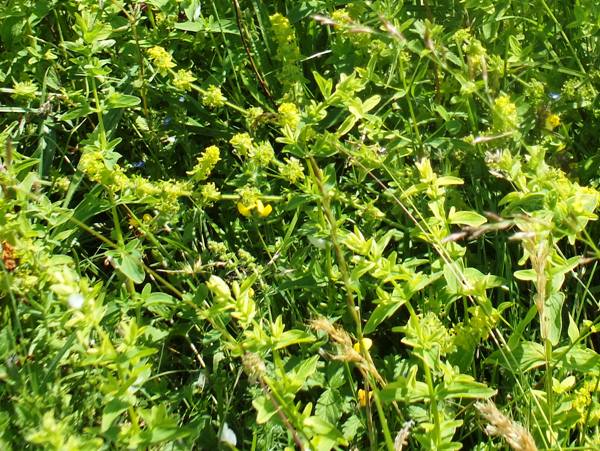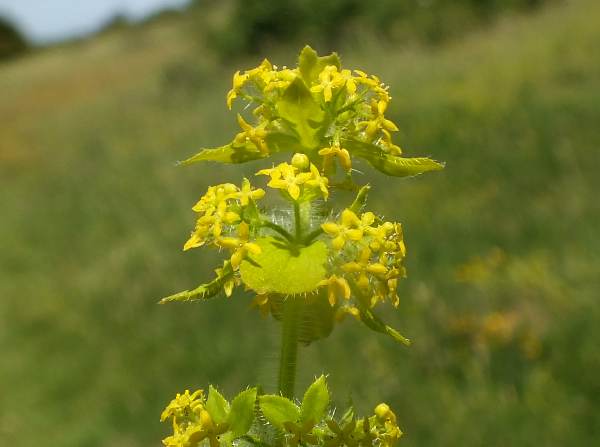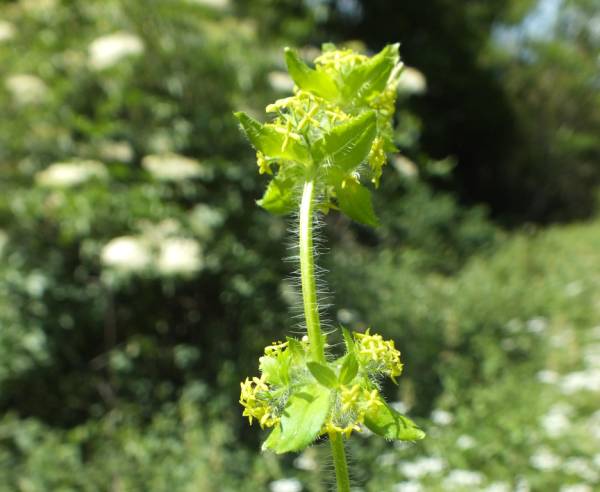Cruciata laevipes - Crosswort
Phylum: Magnoliophyta - Class: Equisetopsida - Order: Gentianales - Family: Rubiaceae

Most other members of the family Rubiaceae have white flowers, so this yellow wildflower is very distinctive and easy to identify. (Lady's Bedstraw also has yellow flowers, but they are borne of frothy clusters at the tips of stems rather than in the whorls that are characteristic of Crosswort.)
Description
Crosswort is a perennial plant with square hairy stems and four-petalled yellow flowers typically 3mm across. The flowers, which smell of honey and are borne in whorls around the stem, occur directly above a leaf-like cross made up of two true leaves and two stipules. The pale green, three-veined oval leaves of springtime darken noticeably as summer approaches.
Distribution
Cruciata laevipes is an occasional to fairly common find throughout much of Britain and Ireland, although it becomes increasingly scarce towards the north of Scotland and is generally absent from areas with strongly acidic soils. This plant is native to most of Europe and parts of Asia, and it is reported to have been introduced to some parts of the USA.

Habitat
Crosswort most often occurs in dry alkaline habitats, and so chalk downland is a very good place to see it; however, in areas of neutral or alkaline soil you will also find Crosswort on well-drained roadside verges, woodland edges and other ungrazed grassland areas.
Blooming Times
In Britain and Ireland the peak flowering period of Cruciata laevipes is April to June, but a few trampled or nibbled plants may resprout to produce sporadic bursts of flowers right through to autumn.
Uses
This plant was reputed to have medicinal properties and was used to treat wounds, ruptures and dropsy and well as headaches and rheumatic pain. The leaves are edible and can either be added to a salad or cooked and used like spinach.

Etymology
The common name Crosswort refers to the leaf-and-stipule structure below each flower whorl in the form of a cross. (The flowers also are like little yellow crosses... but occasionally you maysee some flowers with not four but five petals.)
Cruciata, the genus name, comes from Latin and means 'crossed', a reference to the form of the leaf whorls. The specific epithet laevipes means 'with a smooth foot' and, in this instance, for foot read base of the stem.
Please Help Us: If you have found this information interesting and useful, please consider helping to keep First Nature online by making a small donation towards the web hosting and internet costs.
Any donations over and above the essential running costs will help support the conservation work of Plantlife, the Rivers Trust and charitable botanic gardens - as do author royalties and publisher proceeds from books by Pat and Sue.



